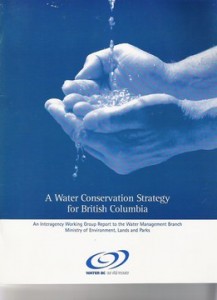Water Sustainability Action Plan for British Columbia: A Partnership Umbrella for On-the-Ground Initiatives
Note to Readers:
Published in 2005, the article below provides historical context for the Water Sustainability Action Plan.
Through a partnership with the Province, program delivery was carried out by the Water Sustainability Committee (WSC) of the British Columbia Water & Waste Association (BCWWA) from 2004 through 2010. The WSC provided the leadership, facilitation and organizational services necessary for successful program implementation.
At the end of 2010, the WSC metamorphosed into the Partnership for Water Sustainability in British Columbia, an autonomous society.
Vision for Water Stewardship and Sustainable Communities
The Water Sustainability Action Plan for British Columbia (i.e. ‘the Action Plan’) provides a partnership umbrella for on-the-ground initiatives that are promoting water stewardship across the province, and that are also informing Provincial policy through shared responsibility.
Inter-Connected Elements
The Action Plan comprises six inter-connected elements that demonstrate how to integrate water management with community planning and development, namely:
- Water $ave Tool Kit for British Columbia
- Water Bucket Website
- Water Balance Model for British Columbia
- Green Infrastructure Partnership
- Convening for Action initiative
- Water-Centric Planning
The goal is to influence choices and encourage action by individuals and organizations so that water resource stewardship will become an integral part of land use and daily living.
 “The Province’s commitment to the Action Plan speaks for itself. The Ministry of Environment has provided core funding over a multi-year period to sustain the efforts of the Action Plan Program Coordinator. In addition, and through participation in various inter-governmental partnerships, a number of Ministries have contributed substantial funding and in-kind support to help launch these Action Plan elements,” stated Kim Stephens, Program Coordinator.
“The Province’s commitment to the Action Plan speaks for itself. The Ministry of Environment has provided core funding over a multi-year period to sustain the efforts of the Action Plan Program Coordinator. In addition, and through participation in various inter-governmental partnerships, a number of Ministries have contributed substantial funding and in-kind support to help launch these Action Plan elements,” stated Kim Stephens, Program Coordinator.
To Learn More:
To download a copy of the Action Plan plus supporting appendices, click on the links below:
- Water Sustainability Action Plan for British Columbia, February 2004
- Appendix B – Provincial Focus Group Findings, December 2003
- Appendix C – A Watershed/Landscape-Based Approach to Community Planning, March 2002
The full title of the report is Water Sustainability Action Plan for British Columbia: Framework for Building Partnerships. The Executive Summary is reproduced below.
Water Conservation Strategy for British Columbia
 The Action Plan builds on the foundation provided by A Water Conservation Strategy for British Columbia, also developed and implemented by the Province in partnership with BCWWA during the period 1997 through 2001.
The Action Plan builds on the foundation provided by A Water Conservation Strategy for British Columbia, also developed and implemented by the Province in partnership with BCWWA during the period 1997 through 2001.
The Strategy offered a general framework and menu of water use efficientcy tools from which to begin assessing water supply and demand management needs. The Strategy encouraged the selection and implementation of these tools to customize a water supply managment plan to local areas and circumstances.
TO LEARN MORE:
To download a copy of the Strategy, click on Strategy Recognized that Water is a Valuable Resource
Framework for Building Partnerships: Executive Summary
The Executive Summary is reproduced below. Alternatively, click here to download a PDF copy of a 2-page document.
Purpose and Scope
The main goal of the Water Sustainability Action Plan for British Columbia (i.e. the ‘Action Plan’) is to encourage province-wide implementation of fully integrated water sustainability policies, plans and programs. The Action Plan:
- Recognizes that the greatest impact on water, land and water resources occurs through our individual values, choices and behaviour.
- Promotes and facilitates sustainable approaches to water use, land use and water resource management at all levels – from the province to the household; and in all sectors – from domestic, resource, industrial and commercial, to recreational and ecosystem support uses.
The purpose of this document is to ‘tell the Action Plan story’ succinctly and clearly. The focus is on the framework for building partnerships because:
- The objective is to obtain funding for implementation of the initial Action Plan Elements.
- The document is intended to be a communication tool – that is, it articulates the vision and the desired outcomes for a ‘watershed / landscape-based approach’ to development.
- The target audience is comprised of those who share a vision for creating transformational change in the way water resources are valued and managed in British Columbia.
The Action Plan Elements are comprehensive in scope, ranging from ‘governance’ to ‘site design’. Element selection also reflects a guiding philosophy to concentrate efforts in those areas where there is the will, the energy and the long-term commitment to create change. Future elements and success will build on the foundation provided by the initial Action Plan Elements.
Integrated Water Management
Integrated water management involves consideration of land, water, air and living organisms – including humans – as well as the interactions among them. Through partnerships, the Action Plan is:
- Forging links as conceptualized in the diagram above;
- Developing a continuum of products, with policy at one end, and pragmatic applications/tools at the other end; and
- Promoting the watershed as a fundamental planning unit.
The Action Plan will use existing and emerging government policies, legislation and programs as fundamental starting points and will build on these.
Action Plan Elements
Land use planning and water management practices are intertwined. For this reason, the intent of the Action Plan is to influence choices and encourage action by individuals and organizations – so that water resource stewardship will become an integral part of land use and daily living.
Partnerships hold the key to building broad-based support for improving water management practices, and for integration of water management with land use.
As illustrated by the graphic below, the Action Plan comprises six elements that holistically link water management with land use, development and resource production. The Action Plan has been developed as a shared responsibility. Its implementation will depend on financial support from both government and the private sector – using a business approach to demonstrate costs, savings and income generation.
Briefly, each Action Plan Element will achieve the following outcomes:
- Water Sustainability Website Partnership: This centralized website will provide the complete story on integrated water management – why, what, where and how. This Element was subsequently rebranded as the Water Bucket – “when the topic is water, just go to waterbucket.ca”
- Water Save Tool Kit for British Columbia: This tool will enable individuals and communities to achieve water conservation and water-use efficiency objectives.
- Water Sustainability Roundtable: This dialogue will provide a starting point for provincial and partnership action, with an emphasis on water governance, policy and practices. Note to reader: This Element was subsequently re-branded as Convening for Action.
- Green Infrastructure Partnership: This initiative will produce a ‘best practice’ Model Subdivision Bylaw and Green Infrastructure Standards for land development regulation. Note to reader: This Element has evolved into a facilitator role that is enabling the Green Infrastructurte Partnership to deliver added value through an outreach and education program.
- Water Balance Model for British Columbia: This web-based evaluation tool at will enable better land development decisions because it quantifies the watershed benefits resulting from implementing stormwater source controls at the site level. Note to reader: To access the model, click here.
- Watershed/Landscape-Based Approach to Community Planning: This adaptable 10-step methodology will facilitate planning with reference to watershed-based features so that resource, land use and community design decisions are made with an eye towards their potential impact on the watershed. Note to reader: This Element was subsequently re-branded as Water-Centric Planning for the purposes of developing a community-of-interest on waterbucket.ca.
“The Action Plan recognizes that numerous groups and organizations implicitly share a vision for integrated water management. Hence, over time it is envisioned that other elements will be added as momentum builds and support grows province-wide for fully integrated water sustainability policies, plans and programs – resulting in conservation and stewardship practices by BC’s enterprises, institutions and in homes,” concludes Kim Stephens.




